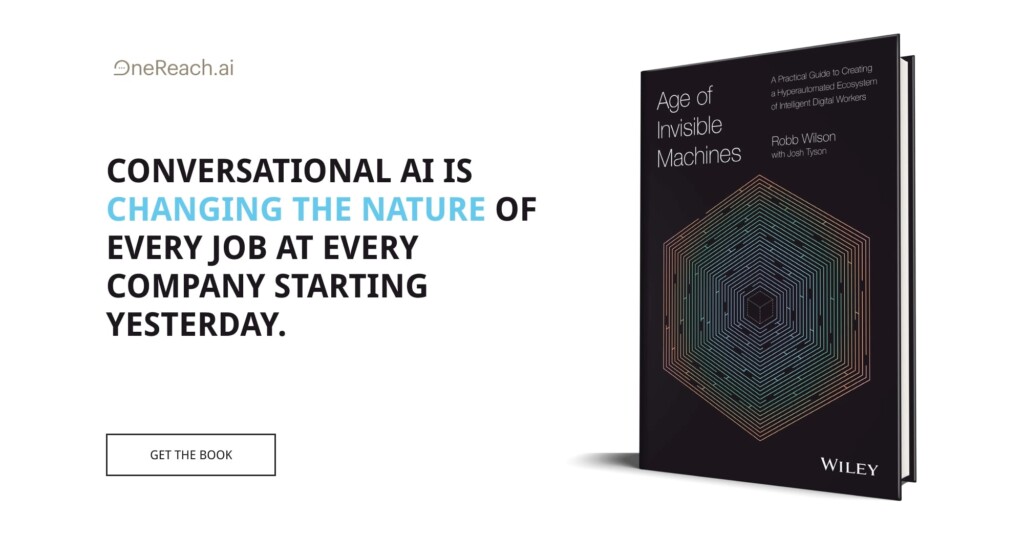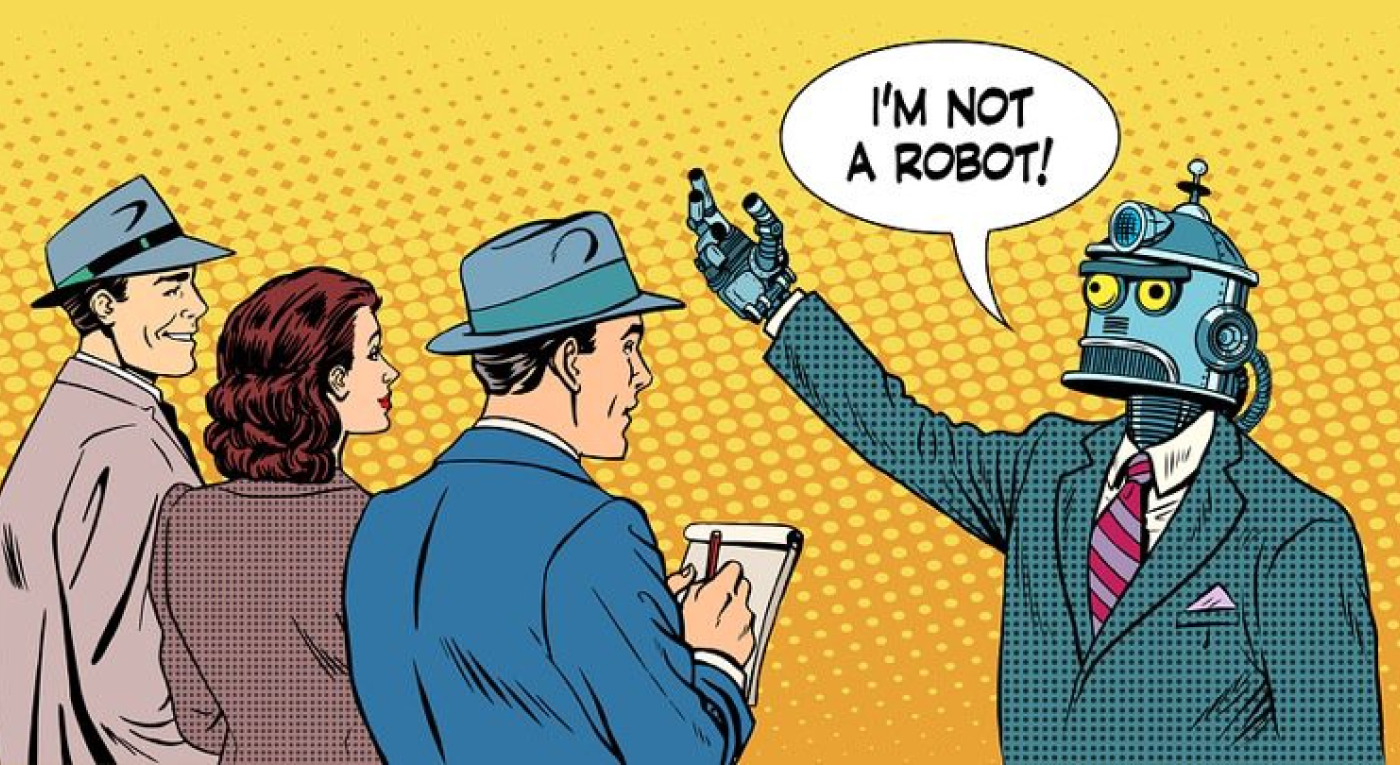As leading chatbot designers have discovered, personality is the number one factor for increasing user engagement.
Click-through rates, sales, and other business KPIs go through the roof when a chatbot is designed correctly, with personality. And last, but certainly not least, chatbots are a heck of a lot of fun to interact with when they have a personality.
But how, exactly, does one design a chatbot personality? After all, there are no Javascript libraries or Github repositories for chatbot personalities that you can access and plug into your design.
A chatbot’s personality is where designers can allow their creativity to come into play. But you don’t need to be William Shakespeare or Charles Dickens in order to add personality to a chatbot.
Does a Chatbot Even Need a Personality?
I get asked that question a lot. Developers, who are usually coming from a tech background, see adding a personality as a lot of difficult, extra work. Clients, on the other hand, are used to thinking in terms of websites and mobile apps and don’t understand the role that a chatbot’s personality plays.
However, asking whether a chatbot needs a personality is looking through the wrong end of a telescope. No matter how basic or simple your chatbot is, the people interacting with it are already assigning it a personality.
Human beings have a strong tendency to anthropomorphize, which is why cars, boats, buildings, and many other inanimate objects have been given names by the people who “use” them. Names have meaning and are powerful indicators of personality, character, and identity.
Chatbots, by their very nature, are completely unlike every other kind of computer-based interaction. Unlike websites and mobile apps, which are designed to deliver the same experience for everyone, chatbots interact with people on a one-to-one basis. And, in many cases, chatbots run on the same messenger platforms that people are already using to talk to their friends and family.
Indeed, the very first chatbot, named Eliza, was built in an MIT computer laboratory in 1964. Members of the office staff, who were fully aware that Eliza was “just” a computer program, still persisted in talking to it (her) as if it (she) were real.
Every chatbot built since then has had similar reactions from ordinary users, who will not only talk to the chatbot as if it were a real person but trust it enough to reveal secrets and seek advice on sensitive personal matters.
The question, therefore, isn’t whether a chatbot needs a personality, but what personality it already has (as perceived by the people interacting with it).
Start With the Chatbot’s Role
Most chatbots are designed in order to advance business objectives, but even if you’re designing a chatbot for an educational, entertainment, or another purpose, the best way to begin building its personality is by assigning your chatbot a role at your company or organization.
In other words, if your chatbot “worked” at your company, what role would s/he have? Even more importantly, what would his/her job title be?
For example, if your chatbot works at a day spa, its job title would probably be receptionist. For a homework chatbot, the chatbot’s “job title” might be a teacher’s assistant. And for a SaaS company, the chatbot’s job might be a “junior sales assistant.”
Flesh Out the Job Description
Once you’ve identified the chatbot’s role and job title, the next step is to write the job description for that position.
For example, here’s a slightly edited real job description for a receptionist position:
Duties and Responsibilities:
- Screen and direct calls accordingly.
- Greet all visitors and direct them accordingly.
- Respond appropriately to queries from the public and customers.
Qualifications:
- 1 year of experience or related experience.
- Must be customer service oriented with knowledge of customer service principles and practices.
- Strong communication skills.
- Must be reliable and dependable.
- Able to maintain confidentiality at all times.
Once you’ve fleshed out the job description, the chatbot that you are designing will become the perfect candidate for this job.
Select Your Chatbot’s Gender
Once you have a clear idea of this ideal employee, it’s time to choose a gender.
While there may be some use cases for genderfluid or transgender chatbots, in general, you need to choose between male or female.
Select Your Chatbot’s Age
Now that you know what job the chatbot will be performing at your company and what its gender is, it’s time to give your chatbot a date of birth.
For a chatbot working as a receptionist, it is theoretically possible that s/he is 60 years old, but it’s not very likely. Instead, most human beings in that role would probably be in their early to late 20s. If that’s the role your chatbot is assuming, then choose an age in that range.
Therefore, choose a date of birth that is realistic for your chatbot’s “work experience” and current job position.
Create a Thumbnail Biography
There’s no need to go overboard with three pages of character description, but it’s a good idea to sketch out a thumbnail biography for your chatbot.
You can answer questions like:
- Married/divorced?
- Dating/single?
- Has kids? If so, how many and what ages?
- Education
- Who else lives in the household?
- Hobbies/Passions
- Favorite joke/quote
- Favorite food(s)/drink(s)
- Favorite TV show/movie/book
Give Your Chatbot a Name
Professional chatbots should always have a “human” sounding name, never something artificial like “InfoBot” or “Chatbot 2000.”
To choose a name, first, identify the chatbot’s cultural identity. For example, a chatbot working at a Finnish company that solely deals with Finnish customers should, of course, be a Finnish “person” with a Finnish name.
Many businesses, however, have a global reach. Therefore, you need to identify a cultural identity that works both with your brand identity and your business model. If your business is headquartered in Britain but most of your customers are in the United States, you’ll have to decide whether your chatbot should be American or British (which affects, amongst other things, how words are spelled).
Once you’ve chosen a cultural identity, look up statistics tables for baby names that were popular for (real) people born during the same generation as your chatbot. Usually, a name somewhere in the top 20 on the list will be a great choice for your chatbot and will leap out at you as the obvious choice.
By choosing a popular name that matches your chatbot’s age and cultural identity, the name will feel a lot more realistic and relatable to the user.
Pro tip: If your chatbot uses a lot of fancy AI and is designed to serve a big enterprise need, you can create a completely unique name for your chatbot that sounds human, but isn’t quite, such as Apple’s “Siri”.
You can pay someone like Cayce Pollard a lot of money to design a unique name for you, but an easier way to do this is by shortening/modifying an ordinary name.
Some examples:
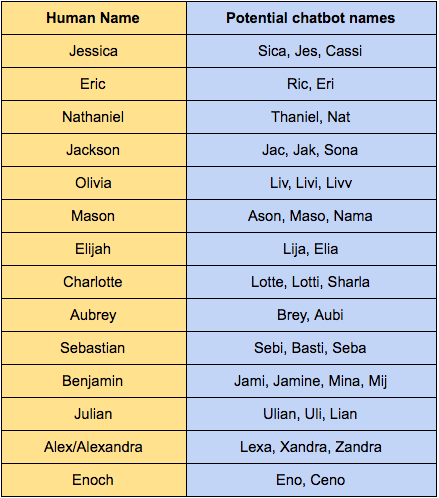
For simple chatbots, however, it’s usually best to go with a standard human name.
Visualize Your Chatbot
If you’re visually inclined, it’s a really good idea to draw an actual picture of your chatbot. You can use computer design/drawing programs or you can simply sketch something on a piece of paper, but it’s really inspirational when you can see what your chatbot looks like.
For example, here’s my conceptualization of an American day spa receptionist chatbot named Jessica:
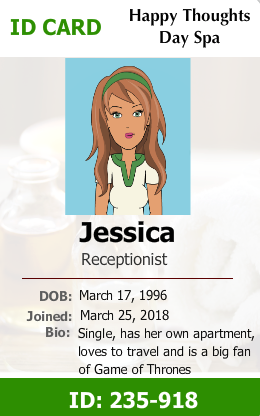
Now Comes the Magic Part
Your chatbot has been given a name, a job title, an age, a gender, and a thumbnail biography. Now, it’s time to bring it to life!
The way that many successful novelists and professional screenwriters do this is by applying standard psychological assessments that were designed for (real) humans. Probably the most famous and ubiquitous personality assessment used today is the Myers-Briggs Type Indicator (MBTI).
The “secret sauce” to making a character (chatbot) come to life is to have him/her “take” the MBTI test, answering each question from the character’s (chatbot’s) point of view. The official MBTI test costs $49, but there are a number of free alternatives online which are more than adequate.
Using Jessica, a chatbot receptionist at a day spa, as an example, I then took the MBTI test from her perspective (not mine):

After answering 60 questions from Jessica’s perspective, the MBTI test revealed that she has an ESFJ personality type, with the results of Extravert (90%), Sensing (22%), Feeling (70%), and Judging (9%).
Once you know the MBTI personality type, it’s easy to find detailed information about what that means:
Extraversion: ESFJs gain energy from interacting with other people. They are typically described as outgoing and gregarious.
Sensing: ESFJs are more focused on the present than on the future. They are interested in concrete, immediate details rather than abstract or theoretical information.
Feeling: ESFJs tend to make decisions based on personal feeling, emotions and concern for others. They tend to think more about the personal impact of a decision rather than considering objective criteria.
Judging: ESFJs are organized and like to plan things out in advance. Planning helps people with this personality type feel more in control of the world around them.
Some common ESFJ characteristics include:
- Kind and sympathetic to others
- Fun and outgoing
- Highly organized
- Practical
- Loyal
- Enjoys helping others
- Self-sacrificing
- Dependable
At this point, a much clearer picture of Jessica’s personality is emerging. And it’s also quite obvious that she would make for a really great receptionist at a day spa!
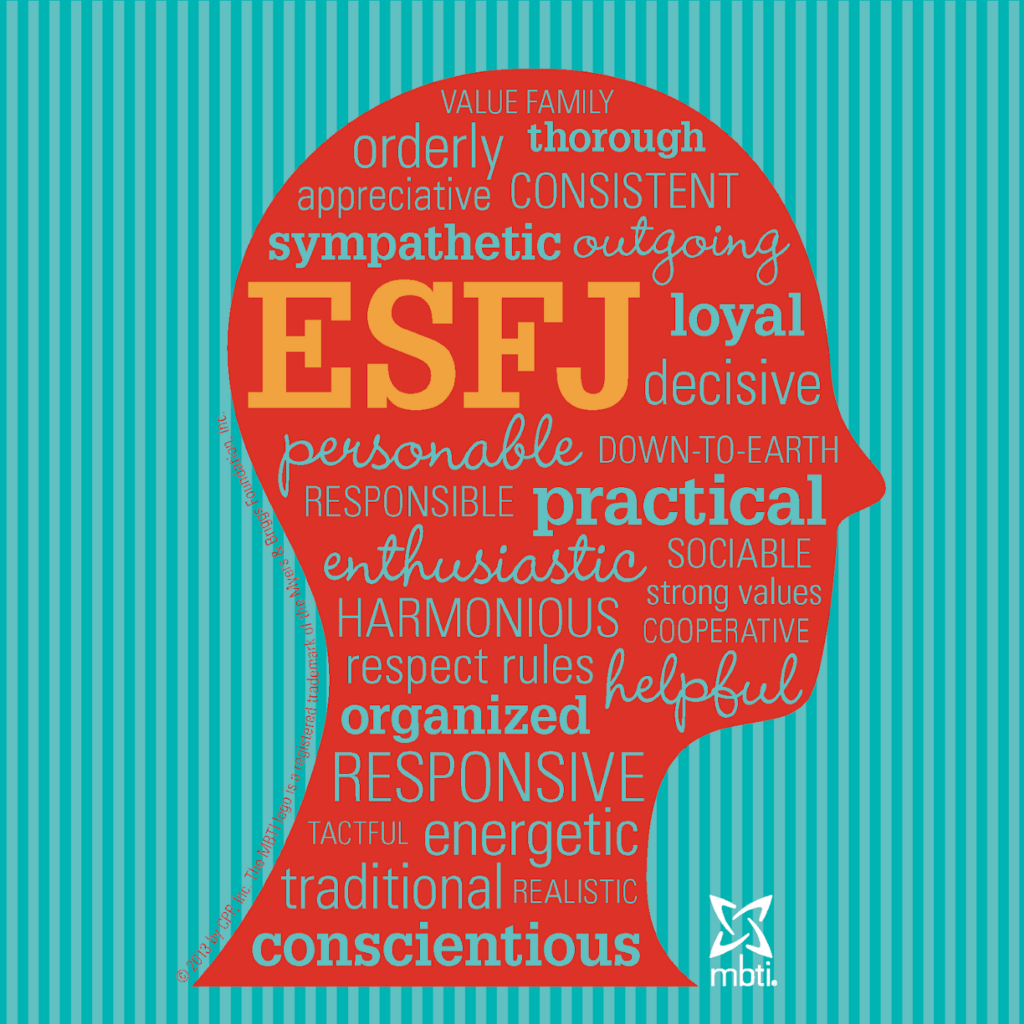
There are hundreds of websites which give further detailed descriptions about each of the 16 MBTI personality types.
Here’s an example:
Guardians of birthdays, holidays and celebrations, ESFJs are generous entertainers. They enjoy and joyfully observe traditions and are liberal in giving, especially where custom prescribes.
All else being equal, ESFJs enjoy being in charge. They see problems clearly and delegate easily, work hard and play with zest. They willingly provide service (which embodies life’s meaning) and expect the same from others.
And here’s another example:
ESFJs often find themselves in occupations that either involve a lot of direct interactions with other people (e.g. clients, other staff members) or involve responsibility for critical tasks (e.g. require thorough attention or may have serious consequences), or both. Very often ESFJs realize their potential in health care and various community care organizations.
Now, we can begin to condense this into a distinct personality for Jessica:
- She would definitely remember birthdays and holidays.
- She’s high-energy and a positive, happy person.
- She likes being in charge (and is a bit bossy, but in a friendly, “mothering” way).
- She works hard and she’s very loyal.
- She gets upset easily but also forgives easily.
- She loves to talk to people.
- She loves to help people.
- She is drawn to health care and other community care careers.
Translating this directly into designing bot behavior, it’s pretty easy to see that Jessica:
- Is a perfect match for a career as a day spa receptionist!
- Would greet customers with enthusiasm and a big smile.
- Would definitely send customers a friendly note on their birthdays.
- Would definitely remember to send a message to customers on every holiday.
- Will respond to problems or difficulties with a cheerful, can-do attitude.
- Is a confident, competent person.
Putting Everything Together
At this point, you should have a really vivid mental picture of who Jessica is.
She’s confident, organized, cheerful, very competent at her job, loves to interact with customers, is thrilled when she can help someone, is very punctual and reliable, and can handle rudeness and “difficult” people with aplomb.

So, how does this translate into chatbot design? The answer is with dialogue (words) and emojis.
If a customer walked into a real day spa, Jessica would definitely respond with an enthusiastic “Hi!” and a smile (smiley face emoji) rather than a tepid “Hello” (and no emoji).
Jessica would cheerfully and competently explain all of the services offered by the day spa. She would respond to a customer’s problems with a can-do attitude, saying things like, “Oh no! Let’s see what I can do to help resolve this.”
She would speak confidently, and use cheerful, high-energy emojis. And if she doesn’t understand something, she will do her best to assure the customer that she wants to understand and help.
Following this same procedure for every chatbot — starting with designating a job title and continuing on to assigning a date of birth, a gender, and a name, plus writing up a brief biography — will give you enough of a foundation to then have the chatbot “take” a personality assessment test. From there, it’s just a matter of applying the personality type to your chatbot through the use of dialogue and emojis.
When you’re done, your chatbot will have a fully developed personality that your users will love, trust, and really enjoy interacting with.
